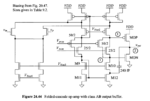Junus2012
Advanced Member level 5

Dear Friends,
I finished with the design of the folded cascode amplifier with resistive load push pull driver, the circuit I used is given by Jakob book and I attached you here,,
Now I need to convert it to fully differential amplifier based on the same topology,
I have searched but didnt find a resource describing how to make this circuit fully differential
I would appreciate very much your help and thank you in advance
best regards
I finished with the design of the folded cascode amplifier with resistive load push pull driver, the circuit I used is given by Jakob book and I attached you here,,
Now I need to convert it to fully differential amplifier based on the same topology,
I have searched but didnt find a resource describing how to make this circuit fully differential
I would appreciate very much your help and thank you in advance
best regards






